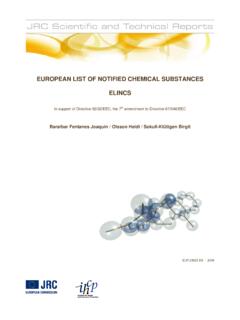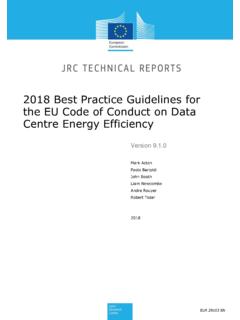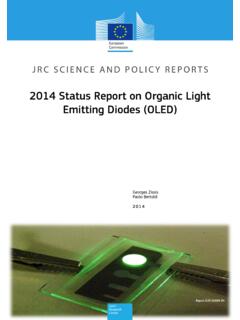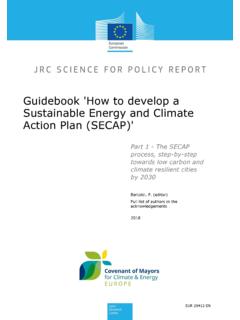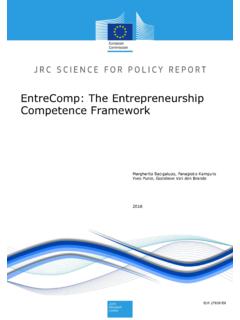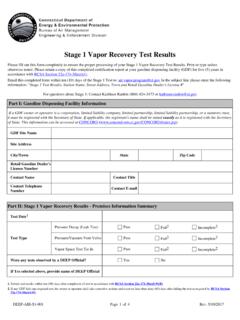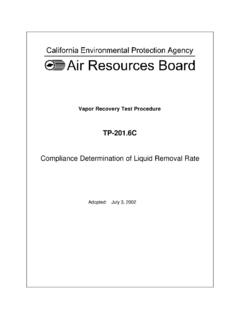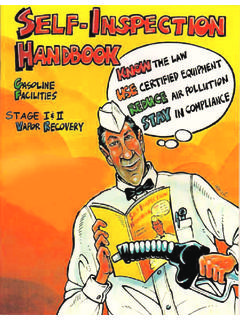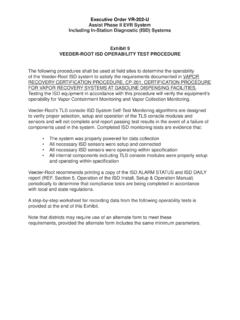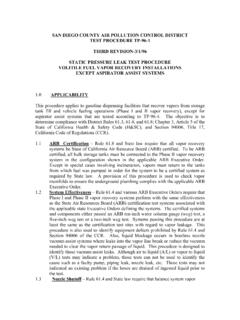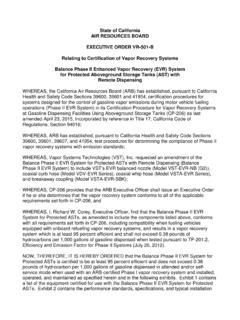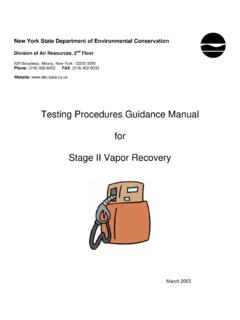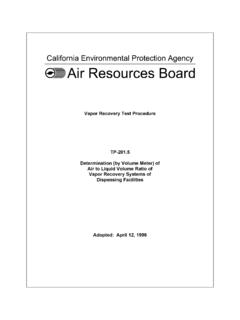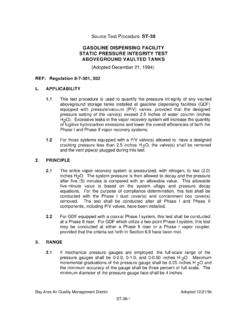Transcription of Review of the European Test Procedure for Evaporative ...
1 Report EUR 25640 EN 2012 Authors Giorgio Martini, Urbano Manfredi, Marta Rocha, Alessandro Marotta Final Report Review of the European Test Procedure for Evaporative emissions : Main Issues and Proposed Solutions European Commission Joint Research Centre Institute for Energy and Transport Contact information Giorgio Martini Address: Joint Research Centre, Via Enrico Fermi 2749, TP 441, 21027 Ispra (VA), Italy E-mail: Tel.: +39 0332 78 9293 Fax: +39 0332 78 5236 This publication is a Reference Report by the Joint Research Centre of the European Commission. Legal Notice Neither the European Commission nor any person acting on behalf of the Commission is responsible for the use which might be made of this publication. Europe Direct is a service to help you find answers to your questions about the European Union Freephone number (*): 00 800 6 7 8 9 10 11 (*) Certain mobile telephone operators do not allow access to 00 800 numbers or these calls may be billed.
2 A great deal of additional information on the European Union is available on the Internet. It can be accessed through the Europa server JRC77061 EUR 25640 EN ISBN 978-92-79-27806-8 (pdf) ISBN 978-92-79-27807-5 (print) ISSN 1831-9424 (online) ISSN 1018-5593 (print) Luxembourg: Publications Office of the European Union, 2012 European Union, 2012 Reproduction is authorised provided the source is acknowledged. Printed in Italy TABLE OF CONTENTS 1. Introduction .. 4 2. Proposed modifications to the EU legislative Procedure for Evaporative emissions determination .. 7 Vehicle and canister pre-conditioning .. 7 Diurnal test .. 9 Durability .. 11 Fuel permeation .. 15 ORVR .. 16 On-Board Diagnostics (OBD) .. 17 Extra costs .. 18 3. Effects of ethanol on Evaporative emissions .. 19 Evaporative emissions : definition and sources .. 19 Effect of ethanol on petrol volatility [9] [10] .. 22 Effect of ethanol on breathing losses.
3 22 Effect of ethanol on fuel 24 Commingling Effect [9] .. 27 Effect of ethanol on refuelling emissions .. 27 Factors affecting real-world Evaporative emissions .. 31 4. Current European legislation on Evaporative emissions .. 35 Comparison between the current European and US legislation on Evaporative emissions .. 38 5. tests performed at the JRC .. 43 Joint EUCAR/JRC/CONCAWE Programme on: Effects of petrol vapour pressure and ethanol content on Evaporative emissions from modern cars [11] .. 43 Effect of petrol/ethanol blends on fuel permeation .. 48 Influence of test Procedure on Evaporative emissions .. 52 Purging strategy of modern cars available on the European market .. 57 REFERENCES .. 62 1. INTRODUCTION The current European legislation on Evaporative emissions dates back to the Directive 98/69/EC (Euro 3-4 standards). Since then neither the emission limits nor the test Procedure have changed. As stated in several legislative documents the European Commission has now the obligation to Review the Evaporative emissions test Procedure in order to improve control of Evaporative emissions : Regulation (EC) No 715/2007 of the European Parliament and the Council Evaporative emissions Article 4 2.
4 In addition, the technical measures taken by the manufacturer must be such as to ensure that the tailpipe and Evaporative emissions are effectively limited, pursuant to this Regulation, throughout the normal life of the vehicles under normal conditions of use..In order to improve control of Evaporative emissions and low ambient temperature emissions , the test procedures shall be reviewed by the Commission. Communication on the application and future development of Community legislation concerning vehicle emissions from light-duty vehicles and access to repair and maintenance information (Euro 5 and 6) - (2008/C 182/08) Evaporative emissions 9. Due to the wider introduction of biofuels, the Commission intends to Review test procedures for Evaporative emissions . This Review should consider whether greater global harmonisation is desirable through alignment of the European test Procedure with that used in the United States.
5 In doing so, consideration may be given to introducing in-service conformity or durability requirements to control the effects of long term use of fuels containing ethanol on Evaporative emissions . According to the quoted documents, there are three different aspects that have to be addressed: A more effective control of Evaporative emissions throughout the normal life of the vehicles under normal conditions of use. A first implication is that the Evaporative emissions should more effectively controlled in real world driving conditions and not just in laboratory conditions. There is evidence that in many cases the Evaporative emissions control systems are designed just to pass the legislative test. In particular, as described in this report, the purging strategy adopted in some models is such that the canister is not purged efficiently when the vehicle is driven at low speeds in urban areas.
6 This can easily lead to saturated canisters that may result in uncontrolled Evaporative emissions especially in hot climate conditions. In addition, in the current legislative Procedure the vehicle is driven over three whole NEDC cycles after the canister loading to the breakthrough and before starting the Evaporative emission diurnal test. This means that the vehicle is driven for a total of 33 km during which the canister is purged. Real world activity data shows that the typical trip length is much shorter especially in urban areas. A more effective control throughout the useful life of the vehicles implies also an improved durability of the Evaporative emission control system. So far in the European legislation there is no Procedure to ensure the durability of the Evaporative control system over the useful life of the vehicle. In the US, in addition to specific durability requirements, the performance of the Evaporative control system are also regularly checked with an in-use verification programme.
7 The impact of ethanol on Evaporative emissions . The European Directive on the promotion of renewable fuels [13] set the objective of 10% coverage of the transport fuel market with renewable fuels by 2020. Ethanol is the most popular renewable fuel at the moment and one of the main options to fulfil the target set by the Directive. However, ethanol has a significant influence on both exhaust and Evaporative emissions of petrol passenger cars when added to the fuel even at low levels (5%). Due to the oxygen content of ethanol, some exhaust emissions may be slightly reduced but some other non regulated pollutants can increase ( acetaldehyde). As far as Evaporative emissions are concerned, ethanol has a significant impact on emission levels as a consequence of the following effects: Increased vapour pressure of the fuel. Increased permeation rate through the plastic material which the tank and fuel lines are made of.
8 Reduced working capacity of the carbon canister used to control Evaporative emissions . Commingling effect. Increased refuelling emissions also due to reduced effectiveness of Stage II refuelling vapour recovery systems. All these effects are discussed in details in the Chapter 3. The EU Regulation (EC) n 692/2008 [14] defines the new reference fuel to be used for type approval tests as far as exhaust and Evaporative emissions are concerned. In particular, for petrol passenger cars a new reference fuel containing 5% ethanol has been introduced in order to reflect the likely average petrol composition in the future. However, as it is demonstrated in this report, the introduction of a new reference fuel containing ethanol may not be sufficient to solve the potential problems on Evaporative emissions due to the presence of ethanol in the fuel. For example, it takes several weeks to reach a stabilized fuel permeation rate when switching from a pure hydrocarbon fuel to a petrol/ethanol blend.
9 Moreover, the reduced working capacity of the carbon canister used to control Evaporative emissions is a long term effect of ethanol. The issues related to the impact of the presence of ethanol in the fuel on Evaporative emissions have been extensively addressed in the past by a large number of studies conducted in the USA. In response to this US EPA and CARB developed specific measures in order to reduce or eliminate the negative effects of ethanol on Evaporative emissions of vehicles. As a results the current US legislation on Evaporative emissions is much stricter than in Europe and consists of different test procedures and specific requirements on components thoroughly covering all the factors influencing Evaporative emissions . The tests carried out at the JRC and in other laboratories have clearly shown that not only do vehicles designed to comply with the US legislation exhibit very low Evaporative emission levels in the legislative test, but in general emissions remain low in more severe tests even using petrol/ethanol blends.
10 These vehicles retain also very good performance in the long term as demonstrated by the in-use verification programme conducted in the USA. On the contrary, the in-use compliance programmes carried out by some EU Member States have put in evidence high failure rates of European vehicles when tested for Evaporative emissions . The results of the in-service conformity programme run by the Swedish Transport Administration (formerly Swedish Road Administration) are particularly worrying; a failure rate of 30% was found while a similar in-service conformity programme run in Germany resulted in a 10% failure rate. Since Sweden is one of the European countries in which ethanol as component of transport fuel is very popular, the result obtained suggests that the higher non-compliance rate could somehow be due to ethanol. The most likely explanation is a reduced working capacity of the carbon canister due to contamination with ethanol.

